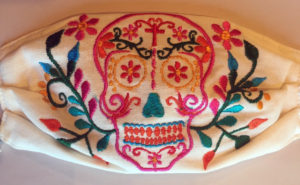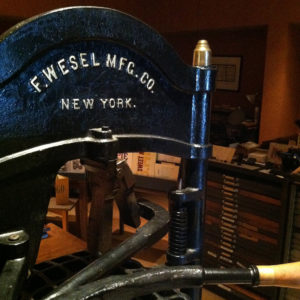My sister, Marietta, has been searching for candied cherries, but I don’t think she’s had much luck. They are an ingredient in the fruitcake we make at Christmastime, and in a biscotti recipe handed down to us from an old family friend, Genevieve Marchione. We didn’t make fruitcake last Christmas, but Cummara Jenny’s biscotti have been in high rotation in the family kitchen, and, alas, all the candied cherries in the pantry were used up in the biscotti. But today, Marietta wanted to make teiglach, the Rosh Hashanah delicacy that remind us so much of the struffoli we make at Christmastime, too (and while it’s ok to skip the fruitcake, you can never skip the struffoli). Struffoli and teiglach both begin the same way, as small balls of dough. The struffoli are fried; the teiglach are baked, so they are healthier. Both are covered in honey. The teiglach are mixed with chopped almonds and candied cherries. For Jews at Rosh Hashanah, they represent sweetness for the new year ahead, and Rosh Hashanah this year begins tonight, with the setting sun, and with the sounding of the shofar, a hollowed out ram’s horn, which gives the day another common name: the Feast of Trumpets. The celebration of the new year concludes ten days from now with solemn Yom Kippur; these are the high holidays/holydays of the Jewish calendar.
Micah 7:19 reads, “You will cast all their sins into the depths of the sea,” and you may find people at the water’s edge during Rosh Hashanah, casting bread into the sea, each bit of bread carrying some of those sins. And with dinner tonight: a round loaf of challah, round to symbolize the circle of the year (as one year ends, another year begins), and, of course, apples dipped in honey… and, with some luck, teiglach, too. L’shanah Tovah.
Tomorrow, the 19th of September, brings the Feast of San Gennaro, which typically manifests as a huge street festival in New York’s Little Italy. This year, no––just a small, socially distanced celebration is taking place. I imagine there were many times in the Old Country, during times of plague and the Black Death, that the street festival for San Gennaro was canceled, too. San Gennaro is St. Januarius––but even in the United States he is mostly known by his Italian name of Gennaro. He is the patron saint of Naples, Italy, and when so many Napoletani migrated to New York at the turn of the last century, San Gennaro became big there, too. The first celebration of the Feast of San Gennaro on the streets of New York City was on his feast day, September 19, in 1926. It is, typically, Little Italy’s biggest feast, and its longest running.
My mother remembers going to the feast when she was a girl. She went for the music and the food and the cute boys (especially the ones in the bands), but she remembers also the procession with the statue of San Gennaro hoisted up on the shoulders of men. Pious observers would pin dollar bills to the saint’s cloak as he was paraded through the city streets, on his way to the church.
I was at one or two San Gennaro feasts myself, when I was a little boy. What I remember most are lights strung up in the night sky, decorations that spanned from pole to pole above the street, sausages and peppers on crusty Italian bread, music and people all around me, and big balloons filled with sand that a kid like me could punch up and down into the air. The balloon was attached to my wrist with a rubber band. It was the best thing ever to the me that was 6 or 7 years old. Better than the lights, better than the food, better than the mobs of people.
One last thing about today: It’s the 18th day of the 9th month, and here in the States, we write that in numerals as 9/18, and 918 is an important sequence of numbers to us letterpress printers, for .918″ is the height of all the types we use in the printers’ trade: all the metal type, all the wood type, all the images, too, be they linocuts or woodcuts or wood-mounted copper plates––everything we print has to be .918″ tall from the base to the printable surface. And so we celebrate today Letterpress Appreciation Day. A fine celebration of the day would involve watching the virtual online Library Wayzgoose Festival I produced for the Jaffe Center for Book Arts. It features Miami designer and letterpress printer Catalina Rojas, music by the Lubben Brothers, and me, I’m your host. Coming in at just over an hour, it’s an event: you’ll want to make some popcorn and pour yourself a little something: make it a grand time. I’m so proud of it, and honestly, can’t believe how well it turned out. I hope you’ll watch today or tonight or anytime you can.
NEW IN OUR CATALOG!
Beautiful Protective Face Masks from Chiapas
We’re so excited about these new additions to our Convivio by Mail catalog: protective face masks, in all sorts of traditional Mexican embroidered patterns, made for us by an extended artisan family in Chiapas. When their usual source of income––tourism to Mexico––dried up this past spring with the COVID-19 pandemic, things were looking bleak. But the family came up with the idea of devoting their skills toward making masks, and we’re pleased to report that the family are now doing well and they are very busy making masks. They appreciate every order that comes in, and we are so happy to help them get their wares out into the world. Visit our catalog and you’ll find the family’s embroidered masks in floral patterns, as well as other traditional Mexican designs: Calavera (above), Frida Kahlo, Maria Bonita, Our Lady of Guadalupe, Sugar Skull, and Otomi-Inspired patterns. We just received a new shipment from them on Wednesday. Masks are $16.50 each plus Free Domestic Shipping with discount code BESAFE (even if you buy just one). Bonus special when you purchase four masks: we’ll take an additional 20% off and ship your domestic order for free (no discount code necessary for that offer). International orders? Contact us and we will see what we can do for you to make shipping expenses as low as possible: mail@conviviobookworks.com.
My apologies for neglecting to click PUBLISH before going to bed last night… the result is subscribers won’t get notification of the post until the wee hours of the morning on September 19. Chalk it up to human error (and this human’s tiredness). Image: Teiglach, as it should look. Purists, you may want to stop reading now, but as it turns out Marietta could not find candied cherries anywhere, so she made this year’s platter of teiglach with chopped dried apricots. Still sweet.



